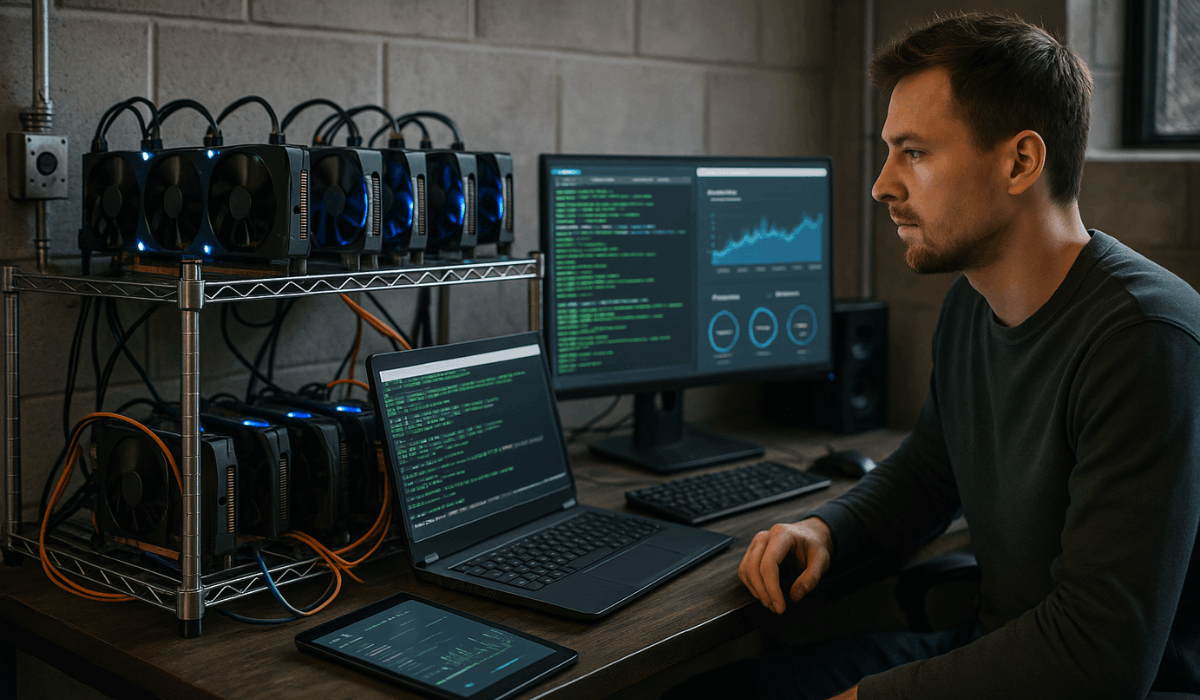Cryptocurrency mining continues to evolve in 2025, offering both opportunities and new challenges for beginners.
If you’re curious about how digital coins are created and whether mining is still worth it, this guide is for you.
You’ll learn how mining works, what tools you need, and how to get started safely and smartly.
What Is Cryptocurrency Mining?
Cryptocurrency mining is the process of verifying transactions on a blockchain network and adding them to a public ledger.
Miners use powerful computers to solve complex mathematical problems, and in return, they earn cryptocurrency as a reward.
This process helps secure the network and keeps it decentralized.

How Mining Works in 2025
Mining in 2025 is more competitive and energy-aware, with updated tools and smarter processes.
Whether you’re using advanced rigs or joining a cloud platform, the core steps remain essential. Here’s a simplified breakdown of how mining works today:
Step 1: Transaction Collection
- Your mining software gathers recent transactions from the network.
Step 2: Block Creation
- These transactions are grouped into a block, ready to be verified.
Step 3: Solving the Puzzle
- Your hardware solves a complex mathematical problem to validate the block.
Step 4: Block Submission
- Once solved, the block is submitted to the network for confirmation.
Step 5: Earning the Reward
- If your block is accepted, you receive a crypto reward and possibly transaction fees.
Step 6: Repeat and Compete
- The process continues, with new transactions and increasing difficulty over time.
Top Cryptocurrencies You Can Still Mine
Even in 2025, several cryptocurrencies remain open to mining, despite industry shifts toward staking and other models.
These coins are popular among miners for their stability, community support, or low hardware barriers.
Here are some of the most mined cryptocurrencies today:
- Bitcoin (BTC): The original and most valuable crypto still uses Proof of Work and requires ASIC miners.
- Litecoin (LTC): Known for faster block times and lower fees, it remains a solid option for GPU or ASIC mining.
- Dogecoin (DOGE): Merged with Litecoin mining via AuxPoW, it’s popular for its accessibility and strong community.
- Monero (XMR): A privacy-focused coin that supports CPU and GPU mining, offering more access for solo miners.
- Kaspa (KAS): Gaining traction for its high-speed block processing and GPU-friendly algorithm.
- Vertcoin (VTC): Built to resist ASIC mining, it’s favored by users who want fairer access with GPU rigs.
Mining Pools vs. Solo Mining
In 2025, miners can choose between working alone or joining others to boost their chances of earning rewards.
Each method has its pros and cons depending on your budget, setup, and goals. Here’s a breakdown of mining pools versus solo mining:
Mining Pools
- Group Effort: You join forces with other miners to solve blocks together.
- Steady Payouts: Rewards are shared based on your contribution, offering more regular income.
- Lower Barrier: You don’t need high-end equipment to earn something.
- Pool Fees: Most pools charge a small fee, usually between 1% and 2%.
- Less Control: The pool operator makes key decisions, such as payout structure and coin choice.
Solo Mining
- Work Alone: You try to solve blocks independently without sharing rewards.
- Full Reward: If successful, you keep the entire block reward and transaction fees.
- High Risk: Long periods with no payout if you don’t solve a block.
- Expensive Setup: Requires powerful hardware and low energy costs to stay competitive.
- More Control: You choose what to mine and when, with no outside rules.
Costs and Risks of Mining
Crypto mining can still generate income, but it demands serious planning and upfront investment.
Hardware and power costs make mining a serious investment. Here are the main costs and risks:
Startup Costs
- Hardware: ASICs and GPUs are expensive, with prices ranging from a few hundred to several thousand dollars.
- Electricity Setup: You may need upgraded circuits, cooling fans, or air conditioning to support your mining rig.
- Internet and Space: A reliable connection and a well-ventilated room are essential for continuous operation.
- Extra Tools: Accessories like surge protectors, mining software, and backup power can increase initial costs.
Ongoing Risks
- High Energy Consumption: Continuous mining leads to substantial electricity bills.
- Hardware Degradation: Mining equipment wears out with use and may require repairs or replacements.
- Market Volatility: Drops in crypto prices can quickly make mining unprofitable.
- Legal Uncertainty: Changes in local or national regulations may impact mining activities or impose new taxes.
- Growing Competition: As difficulty levels rise, rewards become harder to obtain.
Is Crypto Mining Still Profitable in 2025?
Mining can still be profitable, but the margin is tighter than before.
Success depends on balancing costs, efficiency, and the value of the coin you’re mining. Here’s what determines profitability today:
- Electricity Rates: Lower power costs mean higher profits—this is the biggest factor for most miners.
- Hardware Efficiency: Newer machines use less energy and solve blocks faster, improving your return.
- Mining Difficulty: As more miners join a network, the difficulty rises, reducing individual chances of earning.
- Crypto Prices: Higher market value leads to better rewards, but prices fluctuate often.
- Pool vs. Solo Mining: Joining a pool offers steady income, while solo mining may result in rare but larger payouts.
- Maintenance and Downtime: Equipment issues or internet outages reduce uptime, cutting into your earnings.

What Is Cloud Mining?
Cloud mining is a way to mine cryptocurrency without owning or managing physical hardware.
You pay a provider to use their mining equipment remotely, and you receive a portion of the earnings based on your contract.
It’s a hands-off option for beginners who want to participate in mining without the setup and maintenance.
Green Mining and Energy Efficiency
With growing concern over the environmental impact of crypto mining, many are turning to greener solutions.
Miners now focus on cutting power use and emissions. Here’s how mining is going greener:
- Renewable Energy Sources: Miners are using solar, wind, and hydro power to run rigs, cutting reliance on fossil fuels.
- Energy-Efficient Hardware: New ASICs and GPUs are designed to deliver higher performance with less energy.
- Heat Reuse Systems: Some setups recycle mining heat for home or industrial heating, reducing waste.
- Low-Impact Mining Coins: Certain cryptocurrencies are built with algorithms that use less power, making them better for the environment.
- Eco-Friendly Mining Farms: Operators are building data centers in cooler climates to save on cooling costs and reduce emissions.
- Government Incentives: In some regions, tax breaks or credits are available for using green energy in mining operations.
Getting Started with a Test Setup
If you’re new to mining, starting with a test setup is a smart way to learn without risking a lot of money.
It helps you learn how mining works and test performance before investing in costly gear. Here’s how to start with a simple setup:
- Use Your Current PC: Start with your home computer using free mining software to test functionality.
- Choose a Beginner Coin: Pick a coin with low mining difficulty, like Monero or Dogecoin, to see results faster.
- Install Mining Software: Use trusted programs like NiceHash, Kryptex, or XMRig to monitor activity and earnings.
- Track Power Usage: Use tools to see how much electricity you’re using and compare it to potential profits.
- Join a Mining Pool: Connect to a pool to improve your chances of seeing small, regular payouts.
- Observe Performance: Watch temperatures, hashrate, and noise levels to learn how mining affects your system.
The Bottomline
Cryptocurrency mining is still active in 2025, but it requires careful planning, the right tools, and a clear understanding of your goals.
Whether you choose solo, pool, or cloud mining, learning the basics helps you avoid costly mistakes.
If you’re ready to explore mining, start with a test setup and build your knowledge step by step.





